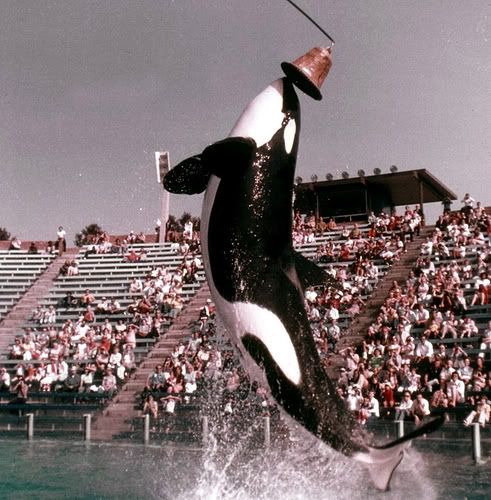
Above: Another vintage killer whale photo.
The Orcinus orca series here at Ark Animals was sparked after I listened to the comments and public misperceptions concerning the Sea World killer whale attack on the marine mammal trainer, Dawn Brancheau.
I’ve been sharing some of the things known by professionals but that are little known by the public.
In this post I’ll be covering a bit about the history of captive orcas, the laws that govern the captive care of these marine mammals and touch on the threats to wild orcas.
Orcinus orca is often depicted in the artwork, masks and costuming of the Pacific Northwest but it has only been since the 1960s that the orca began to be recognized by the general public—and lots of people still don’t realize that they are the largest of the Delpinidae group (dolphin family).
Early orca captures were brutal–a fact I’ve known since I started my career. Controversy surrounds captive orcas and things have changed from people not really knowing or caring about the beast to the widespread concern over the species–both in captivity and in the wild.
The treatment of marine mammals around the world varies greatly due to culture and economic differences.
Recently, dolphin slaughters have come to light in movies such as, The Cove and have served to raise awareness and concern in the United States.
This type of treatment, less sophisticated capture methods and whaling efforts have existed for many, many years, and it is only the awareness that has changed.
Captive collection of orcas began in the late 1930s but it wasn’t until the 1960s that they were being collected for exhibition.
By1999 there were 48 animals on display worldwide. The total listing of both deceased and living orcas today is around 79 or so. (I’ve found discrepancies in the database–in fact Tilikum wasn’t even listed!)
Since marine mammals began being exhibited in marine parks, the governing laws regarding the capture and keeping of orcas (and other species) have been established and enforced.
Laws governing the captive care and management include and involve the:
- Marine Mammal Protection Act
- Animal Welfare Act
- Animal Welfare Information Center
- United States Department of Agriculture & Animal & Plant Health Inspection Service (USDA/APHIS)
- National Environmental Policy Act
In addition, the governing agencies and publications relating to marine mammals include:
- National Marine Fisheries Service (Manages a Marine Mammal Inventory Reports)
- NOAA
- Environmental Impact Statement
- Endangered Species Act
- Marine Mammal Commission
- US Fish & Wildlife Service Federal Register Documents (Congressional Resource Service)
- Federal Register Updates, Changes & Public Comments
Because of the difficulties now involved in the capture and display of orcas, acquisition of existing stock and captive breeding programs are essential for the parks housing them.
Sea World has purchased captive orcas from other aquariums/oceanariums and many of the animals once exhibited elsewhere now reside at different SeaWorld Parks that are owned by Busch Entertainment Corporation (BEC), a division of The Blackstone Group.
Wild Orca Information
Wild orcas face a lot of challenges and the Convention on Migratory Species had a well researched summary about Orcinus orca and included a broad scope of information from capture and impact on wild killer whales.
The following are excerpts from Boris Culik (2010) Odontocetes. The toothed whales: “Orcinus orca”. UNEP/CMS Secretariat, Bonn, Germany.
History of Direct Catch of Killer Whales
- Norwegian whalers in the eastern North Atlantic took an average of 56 whales per year from 1938 to 1981.
- Japanese whalers took an average of 43 whales per year along their coastal waters from 1946 to 1981.
- Soviet whalers, primarily in the Antarctic, took an average of 26 animals annually from 1935 to 1979, but took 916 animals in the 1979/80 Antarctic season (which got a lot of attention).
- After 1976, Iceland was involved in live-captures of killer whales for export. During the period 1976-1988, 59 whales were collected, of which 8 were released, 3 died and 48 (an average 3.7 per year) were exported.
- In 1991, the Icelandic government announced that after expiry of existing permits for live capture, no new ones would be issued.
- Killer whales are still taken in small numbers in coastal fisheries off Japan, Greenland, Indonesia and the Caribbean Islands.
Dangers to Wild Orcas
Today impacts on the wild populations of orcas are severe.
Pollution is a growing problem and high levels of polychlorinated biphenyl (PCBs) and Dichloro Diphenyl Trichloroethane (DDT) have been reported in orcas.
According to Culik’s research, the southern resident and transient killer whales of British Columbia are among the most contaminated cetaceans in the world and killer whales in northern Norway are among the most polluted arctic animals.
Noise pollution and habitat degradation are also is thought to have a negative impact on wild orcas. Specifically, the endangered southern resident killer whales are suffering from noise pollution in their environment.
Habitat disturbance includes whale-watching industries and marine vessels. Propeller scars have been seen on killer whales and are suspected of causing mortality.
Also, environmental hazards such as the 1989 Exxon Valdez oil spill in Alaska hurt the whale population. Two groups of whales (resident AB pod and transient AT1 group) suffered huge losses in the year following the spill.
Heavily exploited species of fish have impact on the ecosystem and it is suspected that killer whale predation changes (such as preying upon sea-otters in Alaska) are because of the significant declines in fish populations due to overfishing and habitat degradation. (Read about the Snake River salmon and orca decline.)
Now there are a lot of other issues I want to get into but that is it for now.
Anything you would like to add? If so, leave your comment below.

